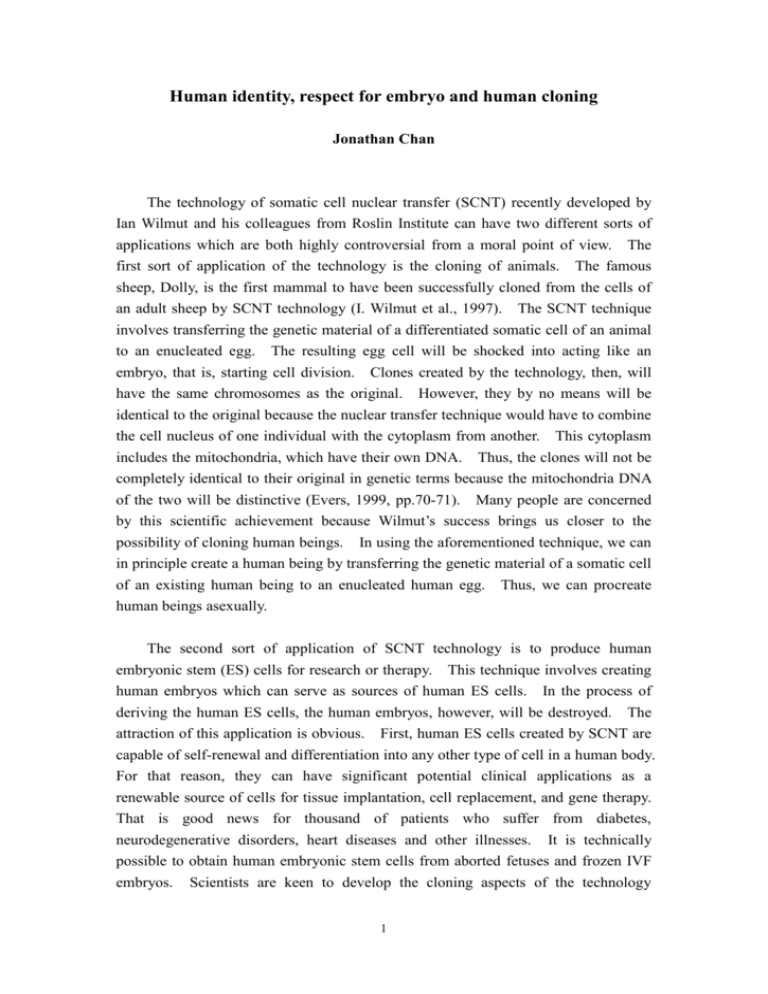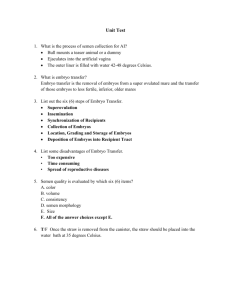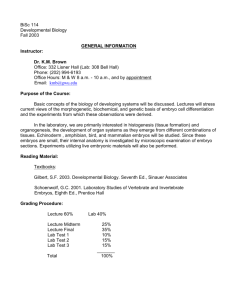Human identity, respect for embryo and human cloning
advertisement

Human identity, respect for embryo and human cloning Jonathan Chan The technology of somatic cell nuclear transfer (SCNT) recently developed by Ian Wilmut and his colleagues from Roslin Institute can have two different sorts of applications which are both highly controversial from a moral point of view. The first sort of application of the technology is the cloning of animals. The famous sheep, Dolly, is the first mammal to have been successfully cloned from the cells of an adult sheep by SCNT technology (I. Wilmut et al., 1997). The SCNT technique involves transferring the genetic material of a differentiated somatic cell of an animal to an enucleated egg. The resulting egg cell will be shocked into acting like an embryo, that is, starting cell division. Clones created by the technology, then, will have the same chromosomes as the original. However, they by no means will be identical to the original because the nuclear transfer technique would have to combine the cell nucleus of one individual with the cytoplasm from another. This cytoplasm includes the mitochondria, which have their own DNA. Thus, the clones will not be completely identical to their original in genetic terms because the mitochondria DNA of the two will be distinctive (Evers, 1999, pp.70-71). Many people are concerned by this scientific achievement because Wilmut’s success brings us closer to the possibility of cloning human beings. In using the aforementioned technique, we can in principle create a human being by transferring the genetic material of a somatic cell of an existing human being to an enucleated human egg. Thus, we can procreate human beings asexually. The second sort of application of SCNT technology is to produce human embryonic stem (ES) cells for research or therapy. This technique involves creating human embryos which can serve as sources of human ES cells. In the process of deriving the human ES cells, the human embryos, however, will be destroyed. The attraction of this application is obvious. First, human ES cells created by SCNT are capable of self-renewal and differentiation into any other type of cell in a human body. For that reason, they can have significant potential clinical applications as a renewable source of cells for tissue implantation, cell replacement, and gene therapy. That is good news for thousand of patients who suffer from diabetes, neurodegenerative disorders, heart diseases and other illnesses. It is technically possible to obtain human embryonic stem cells from aborted fetuses and frozen IVF embryos. Scientists are keen to develop the cloning aspects of the technology 1 because this would yield perfect match tissue that would not be rejected by the patient. Second, human ES cells can be used for research purposes which include in vitro studies of normal human embryogenesis, abnormal development, human gene discovery, and drug and teratogen testing. The first sort of application of SCNT technology mentioned above, sometimes called reproductive cloning, aims at creating human beings, whereas the application of the technology to embryonic stem cells research does not have that purpose. The latter only aims at creating human embryos as sources of human ES cells. For many people, this kind of cloning, call it non-reproductive cloning, is less objectionable because the usual objections to cloning humans, such as risks posed in the cloned child, damage to the cloned child’s uniqueness, violations of the child’s right to an open future, the threat to free will and so forth, do not apply to using SCNT technology for non-reproductive purpose. Walter Glannon is one of those who hold the aforementioned view Cloning should be medically and morally permissible when it is motivated by and used for therapeutic goals...Indeed, this practice would have the virtue of sidestepping the most troublesome moral questions generated by cloning. Cloning cells, embryos, or organs to replace diseased body parts would be either morally permissible or morally neutral, since these parts have no moral status of their own. Nor would cloning threaten our personhood or personal identity, because persons are constituted by but are not identical to their body parts. Genetic identity is not personal identity; unlike cells, selves cannot be cloned. Personhood and personal identity are not simply functions of tissues, organs, or genes (Glannon, 2001, pp.132-33) But how plausible is Clannon’s claim that [c]loning cells, embryos, or organs to replace diseased body parts would be either morally permissible or morally neutral? That depends on one’s view about the rational acceptance of the premise, on which the claim is based, that the body parts [cells, embryos and organs] have no moral status of its own. To people such as Peter Garret, research director of Life, an anti-abortion group in Britain, or Lord Alton, a prominent pro-life campaigner in Britain, the premise put forward by Glannon is obviously unacceptable. For instance, in a BBC interview, Garret argued that therapeutic cloning is simply a form of technological cannibalism. He said 2 [T]hat [therapeutic cloning] is a form of technological cannibalism. These tiny embryonic copies of an individual sick patient are to be plundered for their valuable embryonic stem cells then jettisoned once the parts required for the treatment of the patient have been removed. That is clearly violating the traditional ethical principles that we should not use others as a means to an end (BBC report of 6 April, 2000). The moral reasoning behind such an emotional language used by Garret is that cloning a human embryo to harvest stem cells would be equivalent to creating an individual to plunder the individual of his or her body parts. This moral reasoning presupposes that the moral status of a cloned human embryo is on a par with that of a human individual. Without this presupposition, one should have no qualm about using the “tiny embryonic copies” of an individual sick patient as merely a means to an end. But how plausible is the presupposition that the moral status of a cloned human embryo is on a par with that of a human individual? That depends on one’s view about the moral status of cloned human embryos, which, in turn, to a very large extent, depends on one’s view about the metaphysical status of cloned human embryos. In this regard, two different questions arise: is an embryo created via human cloning technology a human embryo? If so, is it a human individual like one of us? The answer to the first question depends on one’s view about what a human embryo is. There are both similarities and dissimilarities between a human embryo created by fertilization and an embryo created by human cloning technology. An embryo created by human cloning technology would have a potential to become an individual similar to any one of us. In this regard, an embryo created by human cloning technology would not be very different from a human embryo created by fertilization. However, an embryo created by human cloning technology would have far less likelihood or potential than a fertilized human embryo to actually become a human being, because of the subtleties of genetic signaling take place in the case of the fertilized embryo but not in the case of the cloned embryo (Ronald Cole-Turner, 2003, p.9). There is a further significant difference between the two. A cloned embryo is created by taking the nucleus of a somatic cell and putting it into an enucleated egg, whereas a fertilized embryo is created when the fusion of the nuclei of two gametes take place. Now whether a cloned embryo is deemed as on a par with a fertilized human embryo depends upon how one assess the similarity and the dissimilarities between them. If, in contemplating the metaphysical status of a cloned embryo, one takes deep the similarity that both would have a potential to become an individual similar to any of us, then a cloned embryo is no doubt a human 3 embryo. However, if one takes deep the dissimilarities between them, a cloned embryo for the one would be a very different entity from a fertilized human embryo. There is no further fact, whether logical or empirical, that can help to settle the disagreement between the two points of view. Those who take deep the fact that a cloned embryo would have a potential to become an individual like us might argue that it does not matter how the embryo is created or whether it has a high probability to become a human being or not. What matters is its potential to become an individual like us. A similar argument is frequently put forward against abortion. It is often argued that abortion is morally objectionable because it thwarts the fetus’s potential to become a person. If the anti-abortion argument has logical force, so does the argument basing on the cloned embryo’s potential to become a person. As for this argument, it should be noted that a fetus is far more developed than a fertilized embryo and a fertilized embryo has far more potential to become a person than a cloned embryo. Even the gametes about to fuse have the potential to become a person, and their potential to become a person may not be less than the potential that a cloned embryo has. One might also argue that in view of the potential use of SCNT technology, every cell in the human body has the potential to become a person. When talking about the cloned embryo’s potential to become a person, we need to distinguish two senses of the word ‘potential’. According to Jeff McMahan, there are two different types of potential, namely, the identity-preserving potential and the nonidentity potential (McMahan, 2002, p304). We may define these two notions as follows. (D1) X has the identity-preserving potential to become Y if and only if the following conditions are satisfied: (1) there exist some causal relations between X and Y such that X would develop into Y; and (2) X and Y would be one and the same individual identity. (D2) X has the nonidentity potential to become Y if and only if the following conditions are satisfied: (1) there exist some causal relations between X and Y such that X would develop into Y; and (2) X and Y would not be one and the same individual identity. According to (D1), X has the identity-preserving potential to become Y only if X will continue to exist as Y. Thus, Prince Charles has the identity-preserving potential to 4 become the King of England, since he would continue to exist as king. If he realizes that potential, he and the king will be the same person. By contrast, the gametes about to fuse do not have the identity-preserving potential to become a zygote, because the gametes and the zygote and the gametes will not be one and the same entity. Once the zygote is formed, the gametes cease to exist. Nevertheless, the gametes about to fuse have the nonidentity potential to become a zygote. What is the point to make such a distinction? The reason for making the distinction between the identity-preserving potential and the nonidentity potential is as follows. When arguing from an entity’s potential to become a person, the potential involved has to be identity-preserving; otherwise the entity will have no interest in realizing that potential. A tree has the potential to become a piece of wooden furniture. However, it is not in the interest of the tree to become a piece of wooden furniture. The tree ceases to exist when turned into a piece of wooden furniture. By the same reasoning, if an entity, whether a somatic cell or a cloned embryo, has only the nonidentity potential to become a person, the entity will have no interest in realizing that potential. However, if the entity does not have an interest in realizing its potential to become a person, the appeal to the entity’s potential to become a person seems to have no moral insignificance. Or if the appeal has any moral significance at all, that moral significance would not come from the entity itself. For instance, the fact that a somatic cell has the nonidentity potential to become a person by using SCNT technology will not confer a significant moral status to that cell. Now it is clear that what metaphysical status and moral status a cloned embryo would have largely depend on one’s view about what constitutes human identity. For instance, if one holds the person view, one would deny the moral status of a person to human embryos, including cloned embryos, because the human embryos do not have the psychological features such as the ability to think or feel or experience, which are the properties a person must have. By contrast, if one holds the species view that each of us is numerically identical to a particular human organism or human animal which begin to exist at the moment of being conceived, thereby holding the view that human embryos are human beings, just like you and me, one will grant cloned embryos the moral status of a person (Steinbock, 2001, p.21). In a paper discussing the ethics of human cloning, Bonnie Steinbock argues that although human embryos, including cloned embryos, are not persons, thereby having no full moral status, they are a form of human life and, as such, deserving of respect. According to Steinbock, respect for embryos is not like respect for persons. 5 Respect for persons means, as Kant instruct us, never treating persons as mere means to our ends, but always treating them as ends in themselves. This obscure phrase means that we must take seriously the ends - the projects, the goals – that other people have (at least if there’re morally permissible ends). Now we cannot do this with embryos since they do not have ends of their own…embryos cannot given the respect that is due to persons. At the same time, embryos are not just things, but potential human beings. This potential gives them a significance and importance that does not belong to other cells of the body, imposes restrictions on what it is permissible to do to embryos (Steinbock, 2000, p.184-5). If embryos are not persons, why one need to display respect for them? Steinbock appeals to their status as potential human beings. However, as I have shown, the notion of potential is ambiguous. It can mean either identity-preserving potential or nonidentity potential. Since Steinbock sides with the person view of human identity that an embryo is not a person, an embryo’s potential to become a human being for her must be nonidentity potential. This means that should the embryo realize its potential to become a particular human being, the embryo and that particular human being would not be one and the same individual. That being the case, the embryo would not have interest in realizing that potential. That is to say, it does not matter to the embryo whether it could realize its potential to become a human being or not. But then that would render the concept of respect for the embryo very dubious. It is because the language of respect for X implies that the respect which one displays for X should be in some way related to an aspect of X’s well-being. That is to say, the respect for X should be displayed for X’s sake or X’s interest. Steinbock’s argument for displaying respect for an embryo on the basis of its potential to become a human being then would have no basis, because the embryo does not have interest in realizing that potential. Steinbock might be well aware of the dubiousness of her notion of respect for embryos, when she suggested a remedial interpretation for the notion The significance and importance of embryos is, in my view, symbolic. They are owed respect because they are ‘potent symbols of human life’. In this respect, embryos are like dead bodies, which also do not have interests (Steinbock, 2000, p.185). However, it is not clear what it is meant by calling a value ‘symbolic’ or calling embryos ‘potent symbols of human life’. If ‘potent symbols of human life’ means 6 no more than an embryo’s nonidentity potential to become a person, then as I have shown, this potential provides no moral basis for the moral imperative of displaying respect for embryos. Also, if ‘symbolic value’ means no more than assigning a moral value to an entity, then in the case of embryos we need to ask where this value comes from. Without making clear the source of such a value, to accord a ‘symbolic value’ to embryos is simply dubious. Steinbock has argued that respect for embryos is in some way analogous to our respect for corpses We show respect for dead bodies by burying them in accordance with certain social or religious tradition, instead, say, of putting them out with the trash…Similarly, we show respect for human embryos by not using them in unimportant or frivolous ways, say, to teach high school biology or to make cosmetics or jewelry. However, respect for embryos does not require refraining from research likely to have significant benefits, such as treating disease and prolonging life (Steinbock, 2000, p.185). Allowing embryos to be destructed for treating other individuals’ diseases or prolonging other individuals’ lives makes Steinbock’s notion of respect for embryos a strange kind. This strangeness aside, it is just begging the question to place respect for embryos and respect for dead bodies under the same moral category. If ‘respect for dead bodies’ is to be understood literally, that is, meaning that the respect is displayed for the dead bodies’ sake, then the notion is not an intelligible kind, because it does not matter to the dead bodies whether we respect them or not just as it does not matter to the trees or rocks whether we respect them or not. Indeed, ‘respect for dead bodies’ is just a convenient way of expressing the idea that the dead bodies are the bodies of persons who once existed and now ceased to exist, and burying them in accordance with certain social or religious tradition, instead, of putting them out with the trash is to show our respect to these persons who once existed. In developing a sound bioethics, it is a sensible strategy to accord embryos, fetuses or babies some sort of moral significance and importance. The problem is to find a reasonably justifiable basis for the moral significance and importance of those entities. In the case of embryos, there are two different ways to find out such a basis. One strategy is to pick out some property of an embryo, such as its potential to become a person, and take that as the basis for its moral significance and importance, just like the interest theory ethicists take the capacity of having interest as the basis for the moral status of persons. However, if that potential is understood as nonidentity potential, then, as I have shown, one has a hard time to show why this 7 potential is important and for whom. The other strategy is to start with a certain view of human identity, and argue from this view that an embryo is numerically identical to some person, should it realize its potential, in this case, identity-preserving potential, to become a person. Then, from this, one can argue that an embryo is one of us and, thereby, an embryo is not merely something but someone, deserving of respect. This strategy is a more promising one, if one wants to find a basis for the moral significance and importance of embryos. References BBC report of 6 April, 2000, http://news.bbc.co.uk/1/hi/health/703133.stm Cole-Turner, Ronald (2003). “Religion Meets Research.” In: Brent Waters and Ronald Cole-Turner (Eds), God and the Embryo: Religious Voices on Stem Cells and Cloning (pp.7-18). Washington, D.C.: Georgetown University Press. Dworkin, Ronald (1993). Life’s Dominion. London: Harper Collins. Evers, Kathinka (1999). 'The Identity of clones,' Journal of Medicine and Philosophy 24(1), 67-76. Glannon, Walter (2001). Genes and Future People. Oxford: Westview Press. Lockwood, Michael (1995). ‘Human Identity and the Primitive Streak,’ Hastings Center Report 25, no.1, 45. McMahan, Jeff (2002). The Ethics of Killing: Problems at the Margins of Life. Oxford: Oxford University Press. National Bioethics Advisory Commission (1997). Cloning Human Beings: Report and Recommendations of the National Bioethics Advisory Commission. Rockville, Md. Parfit, Derek (1984). Reasons and Persons. Oxford: Oxford University Press. Steinbock, Bonnie (2000). “The Ethics of Human Cloning.” In: Michael Freeman and Andrew D.E. Lewis (Eds), Law and Medicine (pp.177-88). Oxford: Oxford University Press. Steinbock, Bonnie (2001). “Respect for Human Embryo.” In: Paul Lauritzen (Ed), Cloning and the Future of human Embryo Research. (pp.21-33). Oxford: Oxford University Press. Wilmut, I., Schnieke, A.E., McWhir, J., Kind, A.J., and Campbell, K.H.S (1997). “Viable offspring derived from fetal and adult mammalian cells.” Nature, 385:810-813. 8






